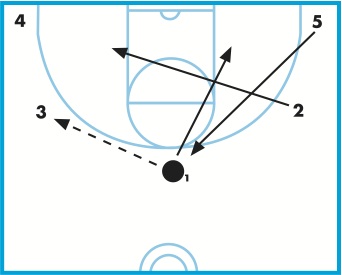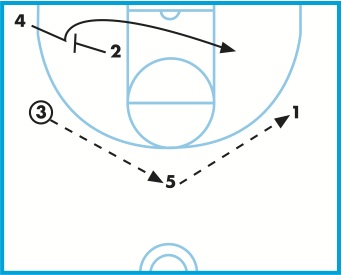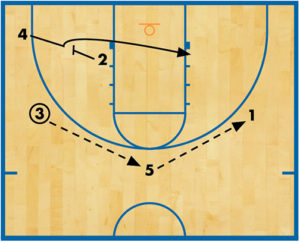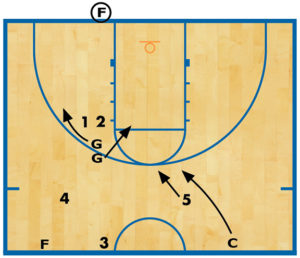Five-man, open-post offense delivers scoring opportunities
Out team has been running a five-man, open-post motion offense for the past three seasons, and each season our offensive production has increased. Our offense has averaged 85 to 94 points per game, been ranked in the top 10 nationally in NJCAA Division III, and we won a state championship.
A special entry that we designed, called “Five,” leads into this motion offense and forces defenders to cover several offensive movements in one play. The defense must try to defend three movements:
- Diagonal cut to the basket.
- Flex cut on the baseline.
- Staggered screen for our best shooter.
If the defense successfully defends all three movements, you can go into the open-post motion. Even if you do not score out of the initial play, you’ve quickly moved the ball from one side of the court to the other and back to the point. Few teams can successfully defend a ball that’s been reversed three times.
 DIAGRAM 1: Initial alignment, wing entry. 1 is at the top of the key, with 2 on the right wing and 5 in the right corner. 3 is on the left wing, and 4 is deep in the left corner.
DIAGRAM 1: Initial alignment, wing entry. 1 is at the top of the key, with 2 on the right wing and 5 in the right corner. 3 is on the left wing, and 4 is deep in the left corner.
1 passes to 3 and cuts away. 2 makes a diagonal cut to the opposite block, looking for the pass. 5 fills in at the top of the key for the ball reversal.
 DIAGRAM 2: Ball reversal with flex cut. 3 reverses the ball to 5. At the same time, 2 steps out and sets a flex screen for 4, who cuts under it. 2 steps in and looks to post up. 5 looks to pass to 4 or 2. If there’s no open pass, 5 reverses the ball to 1.
DIAGRAM 2: Ball reversal with flex cut. 3 reverses the ball to 5. At the same time, 2 steps out and sets a flex screen for 4, who cuts under it. 2 steps in and looks to post up. 5 looks to pass to 4 or 2. If there’s no open pass, 5 reverses the ball to 1.
 DIAGRAM 3: Staggered screen. 3 and 5 set a staggered screen for 2. 1 has the option of a post feed to 4, or a pass to 2 for the jump shot.
DIAGRAM 3: Staggered screen. 3 and 5 set a staggered screen for 2. 1 has the option of a post feed to 4, or a pass to 2 for the jump shot.
 DIAGRAM 4: High-low feed. 3 and 5 widen after they set the screens. 2 shoots the open jumper or can feed 4 in the post. If 4 doesn’t receive the pass and no shot is taken, he or she slides to the corner.
DIAGRAM 4: High-low feed. 3 and 5 widen after they set the screens. 2 shoots the open jumper or can feed 4 in the post. If 4 doesn’t receive the pass and no shot is taken, he or she slides to the corner.
Players can now easily realign into a five-out motion offense. From there, you can run the play again or flow into your basic motion-offense concepts.












